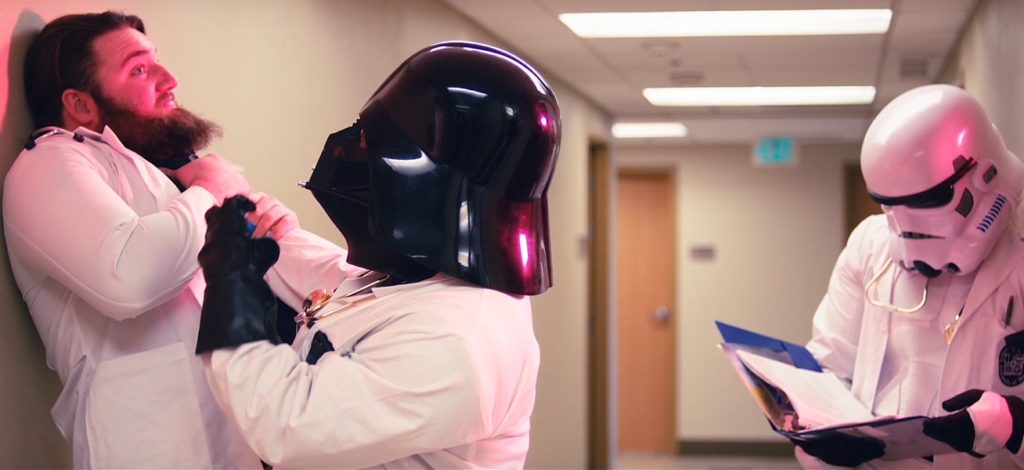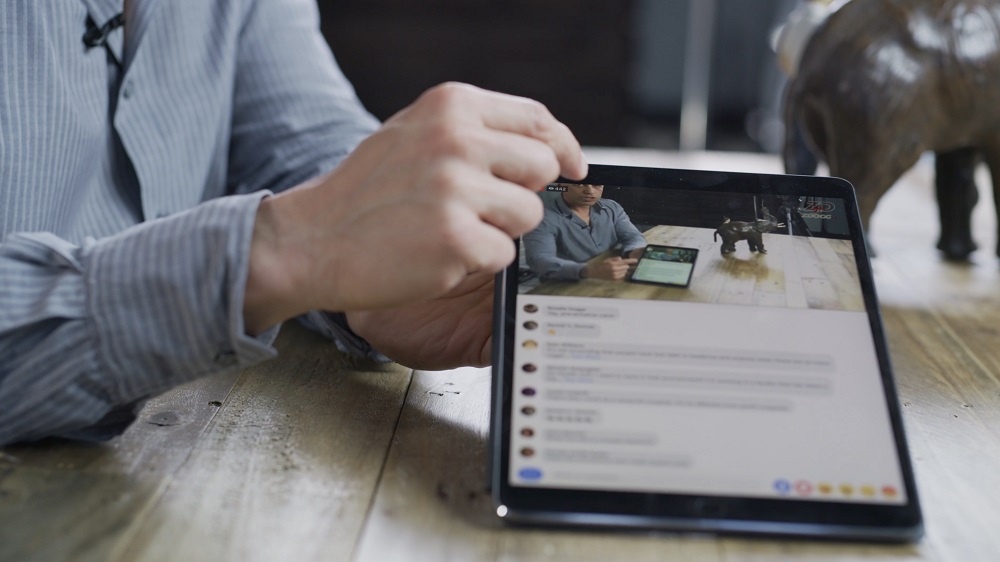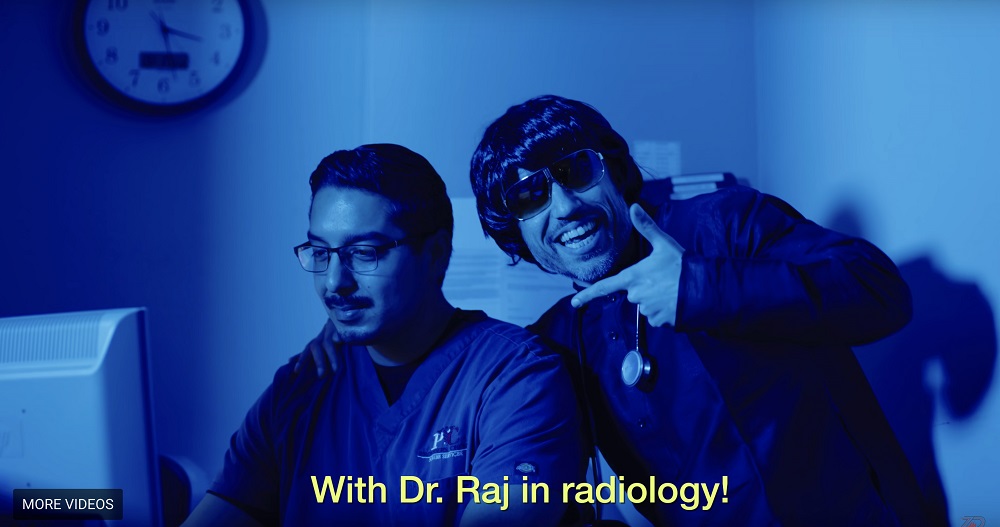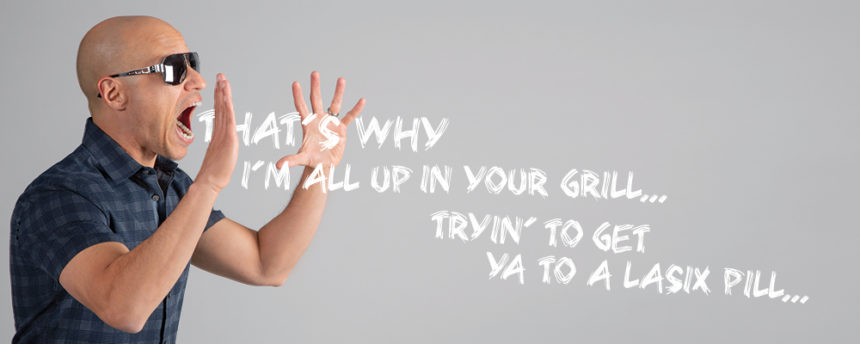Now I’m not trying to be rude but hey, CHF is killing you/Lungs congested up with fluid while my census is 32, croons the doctor on the video, facing the camera as he presides over a patient on a gurney. He’s wearing scrubs under a layer of fur.
That’s why I’m all up in your grill tryin’ to get ya to a Lasix pill, he continues, as nurses and attendings dance in the background. You must be an HMO, the way you’ll NOT be payin’ the bill.
So begins one of the most popular parody videos created by Dr. Zubin Damania — known by his digital nom de guerre ZDoggMD — in what has become an unlikely and prolific musical career. Titled “Readmission,” the video, a spoof on the now disgraced songwriter R. Kelly’s hit “Ignition,” is about the dangers of hospital readmissions.
Let’s just prevent readmissions, manage those chronic conditions, he sings or pleads, depending on how you look at it. Need time preparing the handoff, move along to other clinicians.
Uploaded in June 2015, the video has been viewed more than 2.6 million times on YouTube. Looking back, it was an inflection point. Damania had been making parody music videos since late 2009, but “Readmission” was one of the first he made with the help of a sound guy and a two-person video production team. The effect was catchier, more polished and far more viral.
“I’ve never seen anything like it,” Damania says. In addition to all the views, his YouTube channel was flooded with new subscribers — as of mid-August, he has more than 156,000. “I was like, ‘This is now a real thing.’” In retrospect, it was the singular moment in which Damania — a 46-year-old internist who’s soon to relocate to the San Francisco area from Las Vegas, where his production studio is still based — fully transitioned into ZDoggMD.
Like any social media star over the age of 30, there’s no way Damania could have predicted his career arc. It started normally enough: After graduating from the University of California, San Francisco School of Medicine in 1999, Damania completed his residency in internal medicine and became an adjunct clinical assistant professor of medicine at Stanford University.
He liked aspects of the job, especially teaching medical students and interacting with patients. But the further in his career he advanced, the more the tedious, often soul-crushing elements — checking boxes, filling out forms, optimizing profit — began to wear on him. As an antidote, he started posting hospital-related parody music videos in early 2010.
Since then, the world has changed around him, elevating the skills that make Damania a talented performer into bankable commodities. In no particular order, those skills include legitimate musical ability; an eagerness to participate in stunts like dressing “up in a bathrobe and grabbing [my] crotch” to raise awareness of testicular cancer self-exams; the will and ability to connect with people online; and membership in an industry where humor can be lacking.
While Damania still spends around two or three days a month practicing medicine at UMC Hospital in Las Vegas, the majority of his time is dedicated to running his social media machine — which, over the years, has grown and diversified. In addition to his YouTube channel, Damania maintains an active presence on Instagram (260,000 followers), Twitter (46,000) and LinkedIn (3,000). But the crown jewel is his Facebook page, where he posts prerecorded videos, skits, shows and music parodies three to five times a week. His ZDoggMD Facebook page has more than 1.4 million followers and his Doc Vader one (to showcase “the dark side of ZDoggMD”) has 560,000.

Meanwhile, he is beta-testing a feature on Facebook in which users can subscribe to exclusive content, including videos and a private discussion group, for $4.99 a month. According to Damania, there are already 7,000 paying customers.
Damania is one of the most prolific and high-profile physicians-turned-social-media personalities, but he’s far from the only one. As the world has moved online, so, hesitatingly, have medical professionals. To be sure, the influencer field is sparser than in industries such as design or food, where the barriers to entry are lower, the regulations are lighter and the aesthetics are generally more pleasing.
But with social media’s rise, a number of physicians have made a name for themselves by building a following online. This includes podcasters Rob Orman (17,000 Twitter followers), an emergency medicine physician; Scott Weingart, chief of the division of emergency critical care at Stony Brook Hospital (49,000); and Kevin Pho, a primary care provider who runs the medical blog KevinMD (158,000).
When Damania first began posting on YouTube, he says the channel “was a brave wild west. Nobody knew what was going on.” In those nascent times, he read books about social media strategy and relied on other early adopters — notably Pho, who started KevinMD in 2004 — to guide him.
Now, even in the rarified world of medicine, more doctors have embraced social media, including traditional key opinion leaders such as Eric Topol (171,000 followers on Twitter) and Jack West (15,000).
The trend doesn’t stop with the superstars, either. Particularly in competitive specialties such as dermatology, optometry and aesthetics, maintaining an easy-to-find, engaging online presence is often just the cost of doing business. “Historically, a lot of great doctors weren’t super likable, but that’s changing,” says Christian Rodgers, head of digital at Pascale Communications. With the availability and ubiquity of online reviews, likability has risen in prominence, as have details such as whether a practice has accessible parking, reasonable wait times and a staff that helps patients navigate their health plans and works to prescribe medications covered by insurance.
Doximity, a social network for MDs and other healthcare professionals, was launched in March 2011 with the initial value proposition of giving physicians “the ability to take control of their online professional identity,” says Dr. Amit Phull, the company’s VP of strategy and insights. “Many physicians, myself included, have had a negative experience of Googling yourself and seeing a random negative review or some other kind of untoward information about you through one of the physician review websites.”
The issue, Phull continues, is that “physicians have no recourse to explain themselves or push back if something is inaccurate.” In the early days, Doximity grew because doctors wanted to wrest back control of their online narratives.
In a similar vein, Pascale offers a service called the MD Accelerator, which helps healthcare providers develop and manage their personal brands. Services include “best times of day to build engagement, competitive analysis of top performing content from leaders in your space and what hashtags you should be using.”
Most clients who use the service are simply trying to build or grow their social media presence, Rodgers says. But some, like Dr. Neda Shamie, have more specific endpoints in mind.

In Shamie’s case, she needed help streamlining her personal brand in advance of a new Allergan TV campaign, in which she would be prominently featured. Realizing the ads would generate public interest, not just in her practice but in her individual story, she wanted to create an online presence that showcased her credentials while remaining approachable and authentic.
“We worked with her to develop a whole personal strategy,” Rodgers says. This included highlighting relevant passions, such as her love for the anatomy of the eyeball, which she documented through photographs and videos on Instagram. Within six months, Shamie’s following on the platform grew by more than 1,350 — not necessarily a huge sum in the world of consumer products, but quite large in the physician context.
Amplification is happening on closed, physician-specific networks as well. Doximity works with a select number of users to publish op-eds on a variety of topics. Recent ones have included suicide, multitasking in medical school and the challenges of retirement.
At first, Phull was skeptical physicians would take the time to share personal experiences from their careers. But to his surprise, the platform has taken off, perhaps because physicians lack other channels to discuss more personal aspects of the job.
“Trends and topics like burnout have become quite front-and-center within the industry and more broadly,” he explains. “People, both contributors and readers alike, became aware that this was a place where they could honestly share their experiences and learn from one another. That’s when it began to really pick up.”
Indeed, in an age of oversharing, it’s easy for laypeople to forget that doctors have traditionally lacked established avenues to express themselves. “There isn’t really another outlet quite like it where physicians can share experiences and career milestones and really reflect on the ups and downs of a medical career in a safe professional environment,” Phull says. In recent months, much of Doximity’s most viral content has been personal in nature, from members “reflecting on the death they witnessed in training to the most interesting case they saw last month to ‘this is what it is like to be a trauma critical care surgeon in a very populated city.’”
For Phull, Doximity represents an antidote to the loneliness that often comes with the job. As physicians leave medical school and disperse across the country, it’s difficult to remain in touch. Part of the platform’s appeal is that it “provides that direct connection.”
So as physicians move online, how should marketers respond? Step one is simple: Make sure you’re online. For a variety of reasons, ranging from “no-see” policies at academic medical centers to the ubiquity of tech-enabled communication, doctors have moved away from taking meetings with sales representatives.
“The ecosystem has really shifted now that things have become more digital,” Rodgers says. Reaching influential stakeholders, which in addition to doctors includes nurse practitioners, nurses and administrators, requires reaching out to them in their natural online habitat.
When organizations are selecting a physician to serve as a digital megaphone, it helps to understand that what makes a great social media spokesperson isn’t necessarily the same as what makes a traditional key opinion leader. While the latter typically has deep expertise and stacked credentials in a specific area, the former is often, like Damania, more of a generalist, able to speak to a broad swath of medical professionals.
Making people laugh puts them in a good headspace.
Dr. Zubin Damania
In the online game, less tangible traits, such as delivery style and humor, come more directly into play. Damania gained a platform through his music videos, which work in large part because he’s not afraid to come across as goofy. While he describes humor as a “defense mechanism,” over the years he has realized its value in imparting information to a large audience.
Throughout medical school, Damania taught undergraduates how to prepare for the MCAT. Crippled by feelings akin to impostor syndrome, he cracked jokes to “put myself at ease, disarm the audience and get them on my side so they trusted that I knew enough to help them.” At this point, humor has become one of his most important communication tools. “It’s essential to what I do,” he says plainly. “It’s effective as a mechanism because it gets people remembering and it motivates emotions. Making people laugh puts them in a good headspace.”
In addition to delivering speeches, Damania also works with select companies to produce sponsored posts and videos. Past corporate clients include AthenaHealth and 23andMe, for which he did a series of interviews, including with CEO and founder Anne Wojcicki.
For all sponsored videos, he maintains editorial control. This, he believes, may be why he hasn’t been approached by any major pharmaceutical brands. Companies can also run banner ads on his site, an offer extended by many popular physician-run medical blogs, including KevinMD.com.

For brands looking to connect with high-profile physicians, Rodgers recommends turning to social media. Instagram in particular is full of physicians with large follower counts. They include Dr. Austin Chiang, a physician in interventional and weight loss endoscopy who boasts 23,900 followers; Joyce Kahng, a dentist who has 15,500 followers; and Dr. Lara Devgan, a board-certified plastic surgeon with more than 192,000 followers.
“If you are the agency for Johnson & Johnson and you are looking for doctors who can help promote a product, you are looking on Instagram and you are looking on Facebook,” Rodgers says. Yes, he notes, key opinion leaders are still identified and courted at medical meetings, but “the majority of the action is online.”
In Damania’s experience, healthcare marketing teams “have a real difficult time understanding influencer marketing.” This especially rings true for the kind he does, which is often irreverent and specifically tailored to his viewers.
Unlike celebrity influencers who are selling directly to consumers, he is speaking to an audience of mostly healthcare professionals. By this point, he has an intimate understanding of his audience, and to what they will — and won’t — respond.
“If we do a show, you have to understand the authenticity of the discussion is what matters,” Damania says. “If it looks inauthentic or silly or stupid, no one cares and I won’t do it.”
His pitch to companies is as follows: Give him creative control, and he will create a polished video or series of videos that reach a large audience through his own channels. They can then be distributed as marketing material over the company’s own websites and social feeds.
A natural salesman, Damania’s pitch isn’t done: When companies work with him the right way, he claims, the amount of exposure, influence and inbound marketing they achieve from medical professionals is equivalent to a decade of “going to conferences and setting up booths.” He advises that clients approach him with a call to action, so that results can be measured.
If it looks inauthentic or silly or stupid, no one cares and I won’t do it.
Dr. Zubin Damania
For brands looking to attract social-media-savvy physicians more organically, Rodgers recommends making it as easy as possible for them to engage with a product or service online. “Doctors crave data. They want to become experts in anything they are dealing with,” he stresses.
But when it comes to digesting information and communicating it to patients, “[the appeal] has to be simple.” Rodgers cites Evolus, which makes a soon-to-launch Botox competitor, as a company that does this particularly well.
In addition to generating buzz by inviting plastic surgeons with high follower counts to a company event in Cancun (a move, it should be noted, that has drawn scrutiny from the FTC), Evolus has an easy-to-use app through which doctors can access information and train themselves on how to use the product. “They are very digital-forward,” Rodgers says admiringly. [Evolus is not a client of Pascale Communications.]
As millennials comprise a larger percentage of the profession, the need for marketers to communicate via digital channels will only grow. For example, many younger doctors have grown up learning about new products on YouTube.
“If you talk to a group of residents versus a group of doctors who have 30 years of experience, the residents are not afraid to talk about Snapchat because they’re on it. They get it,” Rodgers says.
Doctors don’t need to communicate on Snapchat, of course, but his larger point is that the shift online is irrevocable. For many providers, saying they aren’t going to create and maintain an online presence is “kind of like saying we don’t need the telephone in our office.”
Indeed, as the industry evolves, Rodgers says social influence will only grow more important to an HCP’s bottom line, particularly in more crowded specialties. “Physicians who are able to develop a reputation online, who make the great work they do in the office come through, are the ones who are going to be better positioned,” Rodgers predicts.
From the September 01, 2019 Issue of MM+M - Medical Marketing and Media







